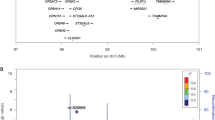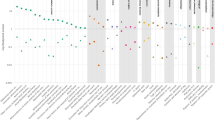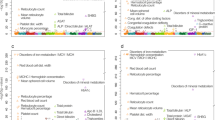Abstract
Interleukin-6 (IL-6) is a key inflammatory cytokine, signalling to most tissues by binding to a soluble IL-6 receptor (sIL-6r), making a complex with gp130. We used 1273 subjects (mean age 68 years) from the InCHIANTI Italian cohort to study common variation in the IL-6r locus and associations with interleukin 6 receptor (IL-6r), IL-6, gp130 and a battery of inflammatory markers. The rs4537545 single nucleotide polymorphism (SNP) tags the functional non-synonymous Asp358Ala variant (rs8192284) in IL-6r (r2=0.89, n=343). Individuals homozygous for the rs4537545 SNP minor allele (frequency 40%) had a doubling of IL-6r levels (132.48 pg/ml, 95% CI 125.13–140.27) compared to the common allele homozygous group (68.31 pg/ml, 95% CI 65.35–71.41): in per allele regression models, the rs4537545 SNP accounted for 20% of the variance in sIL-6r, with P=5.1 × 10−62. The minor allele of rs4537545 was also associated with higher circulating IL-6 levels (P=1.9 × 10−4). There was no association of this variant with serum levels of gp130 or with any of the studied pro- and anti-inflammatory markers. A common variant of the IL-6r gene results in major changes in IL-6r and IL-6 serum levels, but with no apparent effect on gp130 levels or on inflammatory status in the general population.
This is a preview of subscription content, access via your institution
Access options
Subscribe to this journal
Receive 6 digital issues and online access to articles
$119.00 per year
only $19.83 per issue
Buy this article
- Purchase on Springer Link
- Instant access to full article PDF
Prices may be subject to local taxes which are calculated during checkout


Similar content being viewed by others
References
Maggio M, Guralnik JM, Longo DL, Ferrucci L . Interleukin-6 in aging and chronic disease: a magnificent pathway. J Gerontol A Biol Sci Med Sci 2006; 61: 575–584.
Rose-John S, Scheller J, Elson G, Jones SA . Interleukin-6 biology is coordinated by membrane-bound and soluble receptors: role in inflammation and cancer. J Leukoc Biol 2006; 80: 227–236.
Scheller J, Ohnesorge N, Rose-John S . Interleukin-6 trans-signalling in chronic inflammation and cancer. Scand J Immunol 2006; 63: 321–329.
Jones SA, Horiuchi S, Topley N, Yamamoto N, Fuller GM . The soluble interleukin 6 receptor: mechanisms of production and implications in disease. FASEB J 2001; 15: 43–58.
Kanda T, Inoue M, Kotajima N, Fujimaki S, Hoshino Y, Kurabayashi M et al. Circulating interleukin-6 and interleukin-6 receptors in patients with acute and recent myocardial infarction. Cardiology 2000; 93: 191–196.
Yokoyama A, Kohno N, Sakai K, Kondo KI, Hirisawa YUTA, Hwanda KUNI . Circulating levels of soluble interleukin-6 receptor in patients with bronchial asthma. Am J Respir Crit Care Med 1997; 156: 1688–1691.
Nishimoto N, Kishimoto T . Interleukin 6: from bench to bedside. Nat Clin Pract Rheumatol 2006; 2: 619–626.
Nishimoto N, Kanakura Y, Aozasa K, Johkoh T, Nakamura M, Nakano S et al. Humanized anti-interleukin-6 receptor antibody treatment of multicentric Castleman disease. Blood 2005; 106: 2627–2632.
Yokota S, Miyamae T, Imagawa T, Iwata N, Katakura S, Mori M et al. Therapeutic efficacy of humanized recombinant anti-interleukin-6 receptor antibody in children with systemic-onset juvenile idiopathic arthritis. Arthritis Rheum 2005; 52: 818–825.
Galicia JC, Tai H, Komatsu Y, Shimada Y, Akazawa K, Yoshie H . Polymorphisms in the IL-6 receptor (IL-6R) gene: strong evidence that serum levels of soluble IL-6R are genetically influenced. Genes Immun 2004; 5: 513–516.
Wolford JK, Colligan PB, Gruber JD, Bogardus C . Variants in the interleukin 6 receptor gene are associated with obesity in Pima Indians. Mol Genet Metab 2003; 80: 338–343.
Escobar-Morreale HF, Calvo RM, Villuendas G, Sancho J, San M . Association of polymorphisms in the interleukin 6 receptor complex with obesity and hyperandrogenism. Obes Res 2003; 11: 987–996.
Esteve E, Villuendas G, Mallolas J, Vendrell J, Lopez-Bermejo A, Rodriguez M et al. Polymorphisms in the interleukin-6 receptor gene are associated with body mass index and with characteristics of the metabolic syndrome. Clin Endocrinol 2006; 65: 88–91.
Hamid YH, Urhammer SA, Jensen DP, Glümer C, Borch-Johnsen K, Jørgensen T et al. Variation in the interleukin-6 receptor gene associates with type 2 diabetes in Danish whites. Diabetes 2004; 53: 3342–3345.
Ferrucci L, Bandinelli S, Benvenuti E, Di Iorio A, Macchi C, Harris TB et al. Subsystems contributing to the decline in ability to walk: bridging the gap between epidemiology and geriatric practice in the InCHIANTI study. J Am Geriatr Soc 2000; 48: 1618–1625.
Cesari M, Penninx BWJH, Pahor M, Lauretani F, Corsi AM, Williams GR et al. Inflammatory markers and physical performance in older persons: the InCHIANTI study. J Gerontol A Biol Sci Med Sci 2004; 59: M242–M248.
Zuliani G, Volpato S, Ble A, Bandinelli S, Corsi AM, Lauretani F et al. High interleukin-6 plasma levels are associated with low HDL-C levels in community-dwelling older adults: the InChianti study. Atherosclerosis 2007; 192: 384–390.
Ferrucci L, Guralnik JM, Woodman RC, Bandinelli S, Lauretani F, Corsi AM et al. Proinflammatory state and circulating erythropoietin in persons with and without anemia. Am J Med 2005; 118: 1288.
Kahn R . Follow-up report on the diagnosis of diabetes mellitus. Diabetes Care 2003; 26: 3160–3167.
Reich D, Patterson N, Ramesh V, De Jager PL, McDonald GJ, Tandon A et al. Admixture mapping of an allele affecting interleukin 6 soluble receptor and interleukin 6 levels. Am J Hum Genet 2007; 80: 716–726.
Cesari M, Penninx BW, Pahor M, Lauretani F, Corsi AM, Rhys WG et al. Inflammatory markers and physical performance in older persons: the InCHIANTI study. J Gerontol A Biol Sci Med Sci 2004; 59: 242–248.
Zeggini E, Weedon MN, Lindgren CM, Frayling TM, Elliott KS, Lango H et al. Replication of genome-wide association signals in U.K. samples reveals risk loci for type 2 diabetes. Science 2007; 316: 1336–1341.
Scott LJ, Mohlke KL, Bonnycastle LL, Willer CJ, Li Y, Duren WL et al. A genome-wide association study of type 2 diabetes in Finns detects multiple susceptibility variants. Science 2007; 316: 1341–1345.
Saxena R, Voight BF, Lyssenko V, Burtt NP, de Bakker PI, Chen H et al. Genome-wide association analysis identifies loci for type 2 diabetes and triglyceride levels. Science 2007; 316: 1331–1336.
Mullberg J, Oberthur W, Lottspeich F, Mehl E, Dittrich E, Graeve L et al. The soluble human IL-6 receptor. Mutational characterization of the proteolytic cleavage site. J Immunol 1994; 152: 4958–4968.
Wang H, Zhang Z, Chu W, Hale T, Cooper JJ, Elbein SC . Molecular screening and association analyses of the interleukin 6 receptor gene variants with type 2 diabetes, diabetic nephropathy, and insulin sensitivity. J Clin Endocrinol Metab 2005; 90: 1123–1129.
Acknowledgements
This work was supported in part by NIH/NIA Grant R01 AG24233-01 and by the Intramural Research Program, National Institute on Aging, NIH. DM is supported by an NHS Executive National Public Health Career Scientist Award, Ref: PHCSA/00/002. The InCHIANTI study was supported as a ‘targeted project’ (ICS 110.1RS97.71) by the Italian Ministry of Health, by the US National Institute on Aging (Contracts N01-AG-916413 and N01-AG-821336, and 263 MD 9164 13 and 263 MD 821336). The funders had no role in study design, data collection and analysis, decision to publish or preparation of the manuscript.
Author information
Authors and Affiliations
Corresponding author
Additional information
Authors' contributions: SR, TF, KS and DM contributed to the design of this study, and led the statistical analysis, writing and editing of the manuscript. AM participated in the coordination and the design of the study, undertook the genotyping and contributed to the editing of the manuscript. AJH and WH assisted with the statistical analysis and editing of the manuscript. MNW undertook the analysis of the genotyping for quality control. SB, LF and JG led the InCHIANTI study including design and data collection, and contributed to the editing of the manuscript. AMC prepared the InCHIANTI DNA and contributed to the editing of the manuscript. All authors read and approved the final manuscript.
Conflicts of interest
The authors have declared that no competing interests exist.
Rights and permissions
About this article
Cite this article
Rafiq, S., Frayling, T., Murray, A. et al. A common variant of the interleukin 6 receptor (IL-6r) gene increases IL-6r and IL-6 levels, without other inflammatory effects. Genes Immun 8, 552–559 (2007). https://doi.org/10.1038/sj.gene.6364414
Received:
Revised:
Accepted:
Published:
Issue Date:
DOI: https://doi.org/10.1038/sj.gene.6364414
Keywords
This article is cited by
-
Association of the IL-6R gene polymorphic variant rs2228145(C>A) with IL-6 gene polymorphisms in a healthy cohort of Turkish population
Genes & Immunity (2022)
-
Green cardamom plus low-calorie diet can decrease the expression of inflammatory genes among obese women with polycystic ovary syndrome: a double-blind randomized clinical trial
Eating and Weight Disorders - Studies on Anorexia, Bulimia and Obesity (2022)
-
Cathepsin S provokes interleukin-6 (IL-6) trans-signaling through cleavage of the IL-6 receptor in vitro
Scientific Reports (2020)
-
Activation of Toll-like Receptor 2 (TLR2) induces Interleukin-6 trans-signaling
Scientific Reports (2019)
-
Association of the IL6 Gene Polymorphism with Component Features of Metabolic Syndrome in Obese Subjects
Biochemical Genetics (2019)



